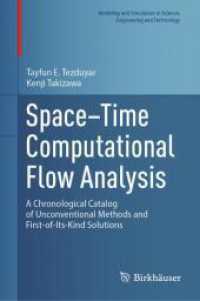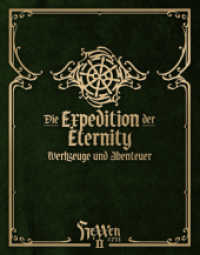- ホーム
- > 洋書
- > 英文書
- > Nature / Ecology
Full Description
Flame and Fortune in the American West creatively and meticulously investigates the ongoing politics, folly, and avarice shaping the production of increasingly widespread yet dangerous suburban and exurban landscapes. The 1991 Oakland Hills Tunnel Fire is used as a starting point to better understand these complex social-environmental processes. The Tunnel Fire is the most destructive fire-in terms of structures lost-in California history. More than 3,000 residential structures burned and 25 lives were lost. Although this fire occurred in Oakland and Berkeley, others like it sear through landscapes in California and the American West that have experienced urban growth and development within areas historically prone to fire.
Simon skillfully blends techniques from environmental history, political ecology, and science studies to closely examine the Tunnel Fire within a broader historical and spatial context of regional economic development and natural resource management, such as the widespread planting of eucalyptus trees as an exotic lure for homeowners, and the creation of hillside neighborhoods for tax revenue-decisions that produced communities with increased vulnerability to fire. Simon demonstrates how a drive for affluence led to a state of vulnerability for rich and poor alike in Oakland that has only been exacerbated by the rebuilding of neighborhoods after the fire. Despite these troubling trends, Flame and Fortune in the American West illustrates how many popular and scientific debates on fire limit the scope and efficacy of policy responses. These risky yet profitable developments (what the author refers to as the Incendiary), as well as proposed strategies for challenging them, are discussed in the context of urbanizing areas around the American West and hold broad applicability within hazard-prone areas globally.
Contents
Preface Acknowledgments Introduction PART I FLAME AND FORTUNE IN THE AMERICAN WEST: AN INTRODUCTION TO THE INCENDIARY 1. The 1991 Tunnel Fire: The Case for an Affluence-Vulnerability Interface 2. The Changing American West: From "Flammable Landscape" to the "Incendiary" PART II ILLUMINATING THE AFFLUENCE VULNERABILITY INTERFACE IN THE TUNNEL FIRE AREA 3. Trailblazing: Producing Landscapes, Extracting Profits, Inserting Risk 4. Setting the Stage for Disaster: Revenue Maximization, Wealth Protection, and Its Discontents 5. Who's Vulnerable? The Politics of Identifying, Experiencing, and Reducing Risk PART III HOW THE WEST WAS SPUN: DEPOLITICIZING THE ROOT CAUSES OF WILDFIRE HAZARDS 6. Smoke Screen: When Explaining Wildfires Conceals the Incendiary 7. Debates of Distraction: Our Inability to See the Incendiary for the Spark PART IV AFTER THE FIRE: THE CONCOMITANT EXPANSION OF AFFLUENCE AND RISK 8. Dispatches from the Field: Win-Win Outcomes and the Limits of Post-Wildfire Mitigation 9. Out of the Ashes: The Rise of Disaster Capitalism and Financial Opportunism Conclusion: From Excavating to Treating the Incendiary Notes References Index



![Optical Nanospectroscopy. Volume 1-2 [Set Optical Nanospectroscopy, Vol 1+2], 3 Teile (De Gruyter Textbook) (2025. XL, 660 S. 300 b/w and 300 col. ill. 240 mm)](../images/goods/ar/work/imgdatak/31104/311043783X.jpg)




